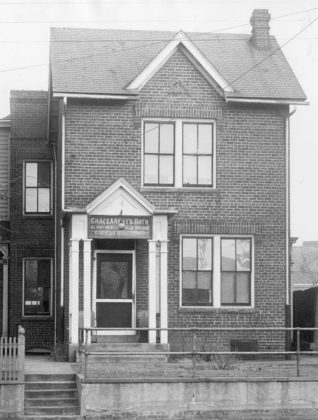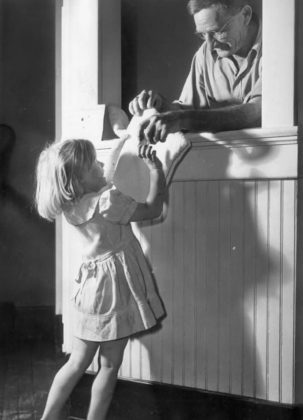Local historian Christopher B. Coleman recently wrote a piece on Richmond’s public bath houses, and while this site has visited the subject before, he supplies a lot more information and graciously agreed to share it here-

In the nineteenth and early twentieth centuries, people visited public baths in towns and cities. Even a city as small as Richmond, Virginia, had one called Charles Beck’s Public Baths in 1832. The enigmatic Beck’s Public Baths token has been a numismatic mystery since the latter part of the 19th century. With its lone obverse device depicting a woman bathing, the only aspect of the token which exceeds the token’s mystery is the beauty of the woman herself. The reverse of the token doesn’t reveal many clues about the token as well. The reverse features the business’ name, two florettes, and its premised city of issue.
However, only a scant bit of evidence to date has emerged that incontrovertibly and inexorably links the token to Richmond, Virginia. The existence of records dating to the Hard Times Era are few, after many public documents were burned during the Civil War.
David Schenkman, author of Virginia Tokens, briefly explored the Beck’s token in the May 1980 edition of The Numismatist. In his essay, he writes that several entries for “Beck’s Public Baths” was uncovered in two Richmond Virginia Deed books.
The first deed entry dated from 1832, and the second was dated from 1844. Both entries listed the owner as Charles Beck, as well as indicated its location on the south side of Main Street between 13th and 14th streets. Along with running a public baths, Charles Beck was also a confectioner. Russel Rulau, in his Standard Catalog of United States Tokens Fourth Edition, estimates that Beck’s business operated from 1832 through 1844.
Fire insurance policies, originating from the Mutual Assurance Society, validate both the existence and the location of Beck’s businesses, as well as confirm most of what Schenkman and Rulau report. Contained within the policies were building maps and the street location, as well as affirmation that not only did Charles Beck operate a public bath facility, but was also a confectioner.
However, what was most suprising from this new research was the discovery that the Beck’s Public Baths businesses may have continued to operate for several years after 1844. Of the insurance documents discovered, one dating from 1851 was also found. Like the earlier policies, the Public Baths property had remained insured. (Policies from 1836, 1844, and 1851 were located.)
What is uncertain, however, is whether Charles Beck himself continued to operate the businesses, or his son took over the enterprise sometime in the 1840s. Census documents from the era confirm the residencies of both Charles Beck Sr. and a son, Charles Beck Jr, both of Henrico. Charles Beck Sr. was born in 1781, and died on June 22, 1848. His son, Charles Jr., was born in 1823, and continued to appear in both the 1850 and 1860 U.S. censuses.
Thus, if the business had remained open up until 1851, as the fire insurance documents appear to confirm, it would have been his son who continued the operations. Indeed, looking closely at the 1851 document, it appears that the “JR” suffix is noted after the Charles Beck name.
Three varieties of the Beck’s Public Bath tokens are known. The more common variety, struck in copper, is cataloged by Rulau as HT-441, and has an estimated rarity rating of R-3. The second variety, struck in German silver, is quite rare, and is cataloged by Rulau as HT-441A. It’s rarity rating is R-8. Likewise, the third variety struck in white metal, and is cataloged as HT-441B. It is equally rare.
As to the token’s beautiful design, in 1999 numismatist Wesley Cox researched and through die analysis demonstrated that Beck’s tokens were produced by the firm of James Bale of New York. Given the uncertainty of exactly when its dies were cut, its design may have also involved engravers Charles Cushing Wright, or Frederick B. Smith.
All varieties, when they are seldom encountered, are most often found in lower grades. Given this, it is surmised that the tokens were heavily used by the Richmond public.
There were other public bath houses in Richmond in operation until the 1950’s.
In a time when many people did not have access to running water, a local banker and philanthropist named John P. Branch established a public bath at 1801 Broad Streets in 1909. A brick building that still stands at 1801 East Broad Street, Branch Public Bath #1 used coal-fired boilers to provide hot water for showers and tubs on the second floor.
These grew so popular that four years later, he built the more beautiful Branch Bath #2 at 709 W. Main Street. The bath house was erected in 1913 on a small midblock parcel facing Monroe Park. Branch deeded both buildings to the city with the stipulation that the city appropriate $3,000 annually to maintain each facility. At the peak of use in the early 1920s, the two baths were patronized by 80,000 people per year.
At each, any white Richmonder (like so many other amenities in the city, the public baths were segregated) for ten cents, a bather would receive a sterilized towel, a bar of soap, and a set (yet largely unenforceable) bathing time: twenty minutes for men, thirty minutes for women. Admission for children was 3 cents.
Winter was the busiest time, since people tended to bathe in creeks and lakes during the warmer months. As indoor plumbing became more common, however, patronage waned and both baths closed in 1950.
John Zehmer of the Historic Richmond Foundation wrote in his new book, THE CHURCH HILL OLD & HISTORIC DISTRICTS, that the Branch baths served 60,000 bathers a year. “The cost [in the early 1900s] was five cents for adults and three cents for children. The bath was popular with judges, doctors, lawyers, and all classes of people because it was so much better than what was available at home. The development of indoor plumbing led to the closing of the public baths . . .”
Residents used a backyard privy as a toilet, and bathed in wash basins or in nearby waterways. Most early Americans took sponge baths, standing beside their washstand with its pitcher and bowl of water or in a small tin tub with a few inches of warm water, usually in their bedchamber. Servants or slaves, if one were wealthy enough to have them, brought buckets of water from the pump, heated it in kettles on the stove, and lugged it up the stairs to the shallow tub. Otherwise you did the chore yourself. Ladies often preferred to put the tub by a fireplace. Some people bathed in the kitchen, nearer the stove, less privacy but less carrying. Many who were willing to wash their bodies while standing in a basin were unwilling or unable to immerse themselves fully in a large tub.
Interestingly, bathing and washing didn’t necessarily include the use of soap, at least not until the 19th century. The association of bathing with soap began in the 1830s, representing “a new fastidiousness about body odor that increased the labor required to achieve decency.”
One thing’s for sure, people washed their hair less often than we do today. A women would have had to spend half her daylight hours sitting by the fire or in the sun to dry her long tresses. Hair styles reflected this reality. Until the 1920s when American women began cutting their hair short for the first time, most braided, knotted, or twisted up their long hair and wore it under a cap or bonnet. The invention of the electric hair dryer allowed a greater variety of styles.
In the 1870s, the discovery of germs helped boost the idea of cleanliness in Europe and America. Modern indoor bathrooms with a sink, tub, and toilet in one room, gained popularity from the 1920s on. But even then, by 1940 (just before World War II), only half of American homes had this sort of modern bathroom.

In 1979, VCU redeveloped the entire block as Gladding Residence Center, but preserving a portion of Branch Bath #2’s façade as the entry to the complex. The bathhouse had found a new purpose, but was now uncomfortably shoehorned between two wings of the new complex.
Four decades later, GRC was outgrown and outmoded, and VCU needed to replace it. The university engaged Ayers Saint Gross as Design Architect and Clark Nexsen as Architect of Record, along with American Campus Communities, to create a new student housing complex that meets the evolving needs of a 21st-century student population.
But what to do about the bathhouse? It was awkwardly located at not-quite-midblock. Its Renaissance aesthetic contradicted VCU’s image as a forward-looking, innovative institution. But the residents of the adjacent neighborhood saw the bathhouse as a beloved artifact of the district’s history. Any effort to demolish it would be met with stiff community opposition, and relocation costs were prohibitive. The bathhouse had to stay.
Ayers Saint Gross as Design Architect grappled with how to incorporate it into the new GRC. Architectural massing is a push-pull of external and internal forces, and student housing is no exception. The need for exterior space-making and articulation must be balanced with the internal scales of the unit module and the RA community. Adding a randomly-sited, 100-year-old architectural folly into the equation only complicated matters still.
In the end, the solution was subtractive. The design team made space for the bathhouse by carving out a zone of units on one side of the corridor, in the process producing multiple positive outcomes.
The bathhouse, which threatened to be a thorn in the side of the project, became an asset. Its limestone exteriors have been cleaned, and its leaky casement windows were replaced with contextually-designed insulated units. The graphic design studio even faithfully recreated the long-vanished “BRANCH PUBLIC BATHS” engraved signage that adorned the stone entablature.
The bathhouse structure now houses community space for GRC residents on its first floor, and a media lounge on the second story. The full integration of old and new at GRC serves as a reminder that cities, like campuses, are a collage of eras. Source: Times-Dispatch, historymyths.wordpress.com, Laura Carr, thevalentine.org, asg-architects.com
